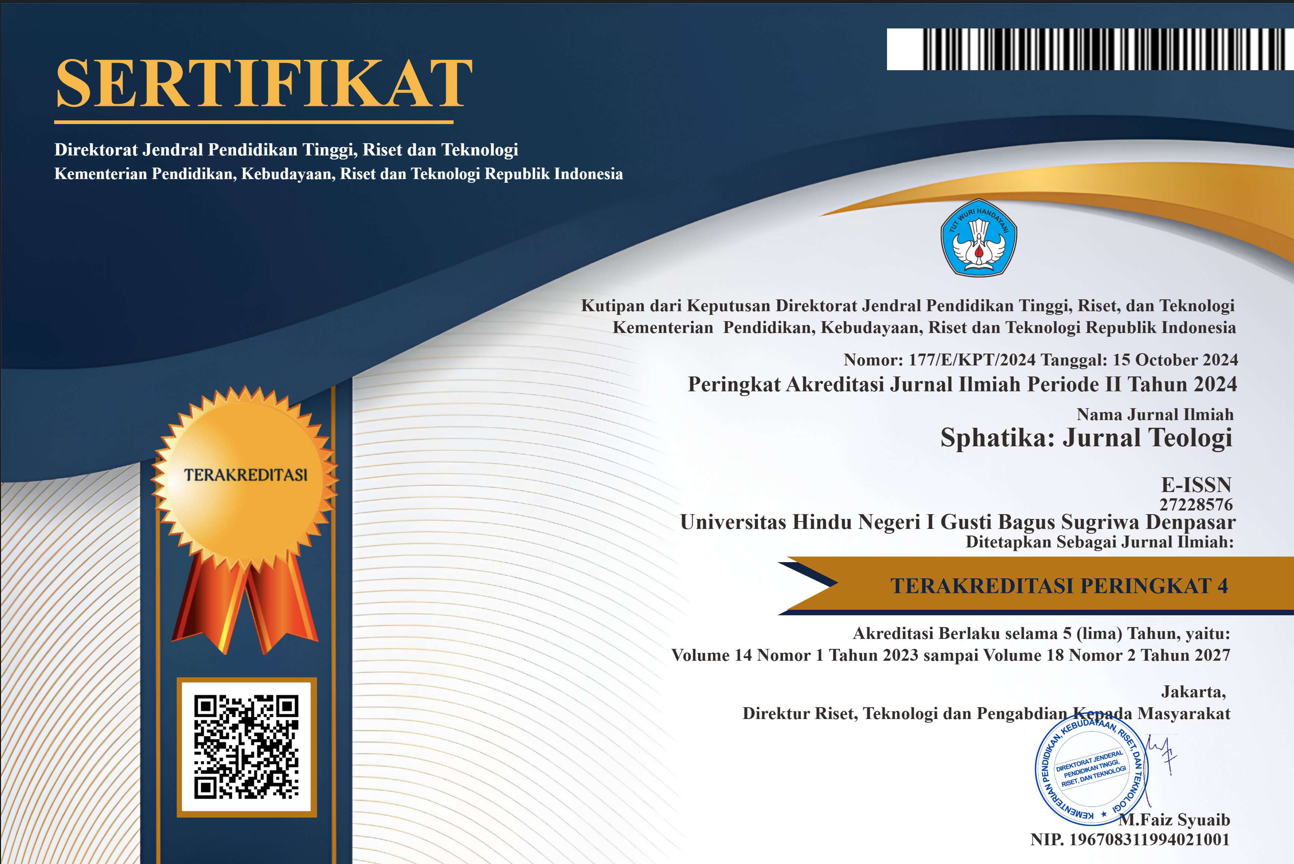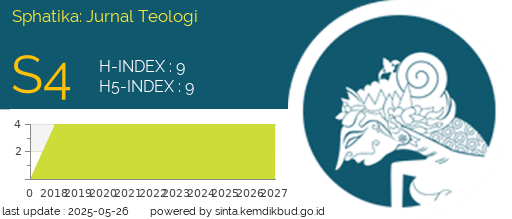Pementasan Calonarang Gabos di Desa Bongkasa
(Kajian Estetika Hindu)
DOI:
https://doi.org/10.25078/sphatika.v15i1.3652Keywords:
Calonarang Gabos; harmony; Hindu aesthetics.Abstract
Calonarang Gabos is one of the performing arts which is staged at the Piodalan ceremony at Griya Sakti Manuaba Temple, Bongkasa Village as a medium of transcendental communication between worshipers and those who are worshiped, so Calonarang Gabos is called a sacred art that is full of sacred, tenget, religious and magical values to neutralize negative power. The Satyam, Sivam, Sundaram trilogy becomes a harmonious whole in the Calonarang Gabos performance, so that it is able to achieve a balance between sekala and niskala.
This research uses Religious theory, Aesthetic theory, and Structural Semiotics theory to discuss the overall problem formulation in this study. The research method used in this study is a qualitative research method that emphasizes extracting information in the field by observation and describing it in narrative form that emphasizes theological, aesthetic values and the implications arising from the staging of Gabos Calonarang on the community in Bongkasa Village.
The religiosity of the Calonarang Gabos performance is reflected in the religious emotions that are still very strong in the Bongkasa Village community which is able to become the basic foundation for the staging process to take place. Apart from the religious emotions, the Calonarang Gabos performance is also supported by a strong belief system in the power of Ida Bhatari Dalem, which is supported by the ritual system and the surrounding community, who are still consistent in maintaining the preservation of the arts through staging events. The Hindu aesthetic values contained in the Calonarang Gabos performance are Satyam, Sivam, and Sundaram. As well as the meanings contained in the Calonarang Gabos performance are theological meanings, social meanings, educational meanings, and balance meanings.
References
Agung, I. G. (2007). Dramatari Calonarang di Desa Pakraman Tegaltamu, Desa Batubulan, Sukawati, Gianyar (Kajian: Bentuk, Fungsi, Makna). Denpasar: Program Pascasarjana Institut Hindu Dharma Negeri Denpasar.
Ali, S. S. (2000). Berkenalan dengan Prosa Fiksi. Yogyakarta: Gama Media.
Ambarnuari, M. (2016). Teo-Kosmologi dalam Teks Bhuwana Mahbah. Denpasar: Fakultas Brahma Widya Institut Hindu Dharma Negeri Denpasar.
Arikunto, S. (2002). Prosedur Penelitian Suatu Pendekatan Praktek (Edukasi V). Jakarta: Rineka Cipta.
Arvin, S. (1978). Natya Sastra. Callkuta: Delhhi Press.
Asmani, J. M. (2011). Tuntunan Lengkap Metodelogi Praktis Penelitian Pendidikan. Yogyakarta: Diva Press.
Atmaja, I. G. (2008). Pementasan Dramatari Calonarang di Desa Adat Banjar Tanggahan Peken Desa Sulahan Kecamatan Susut Kabupaten Bangli. Denpasar: Program Pascasarjana Institut Hindu Dharma Negeri Denpasar.
Bandem, I. M. (1998). Geliat Seni Pertunjukan Tari Bali. Denpasar: Isi Denpasar.
Bandem, I. M. (2010). Mungkah Lawang Seni Pementasan Bali. Denpasar: STIKOM Bali.
Bandem, I. M. (2013). Gambelan Bali di Atas Panggung Sejarah. Denpasar: STIKOM Bali.
Koetjaraningrat. (1974). Kebudayaan, Mentalitas dan Pembangunan. Jakarta: Penerbit Gramedia.
Ratna, N. K. (2010). Metodelogi Penelitian Kajian Budaya dan Ilmu-Ilmu Sosial Humaniora Pada Umumnya. Yogyakarta: Pustaka Pelajar.
Robson, S. O. (1978). The Ancient Capital of Bali. Archipel, Vol. 16, pp. 75-89.
Roson, Z. P. (2004). Kamus Jawa Kuna Indonesia. Jakarta: PT. Gramedia Pustaka Utama.
Rtizer, G. G. (2012). Teori Sosiologi. dari Sosiologi Klasik Sampai Perkembangan Terakhir Postmodern. Yogyakarta: Pustaka Pelajar.
Triguna, I. B. (2003). "Estetika dan Kebudayaan Bali", Dalam Estetika Hindu dan Pembangunan Bali. Denpasar: Widya Dharma.
Wirawan, K. I. (2017). Pementasan Dramatari Calonarang di Kota Denpasar Perspektif Teo-Estetika Hindu. Denpasar: Program Pascasarjana Institut Hindu Dharma Negeri Denpasar.















